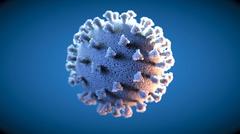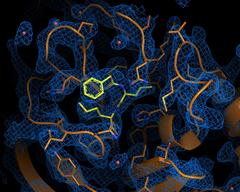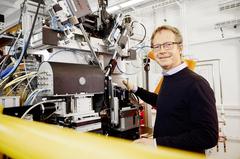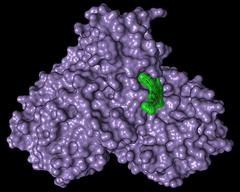URL: https://www.desy.de/news/news_search/index_eng.html
Breadcrumb Navigation
DESY News: DESY X-ray lightsource identifies promising candidates for COVID drugs
News
News from the DESY research centre
DESY X-ray lightsource identifies promising candidates for COVID drugs

In a massive X-ray screening, scientists identified promising candidates for drugs against SARS-CoV-2 (artist's impression). Credit: DESY, Science Communication Lab

Electron density map of the most antiviral active ingredient calpeptin (yellow) binding at the main protease. Credit: DESY, Sebastian Günther
Beamline P11 of DESY´s PETRA III research lightsource specialises in structural biology studies. Here, the three-dimensional structure of proteins can be imaged with atomic precision. The research team led by DESY physicist Alke Meents used this special capability to examine several thousand active substances from a library of the Fraunhofer Institute for Translational Medicine and Pharmacology and another library from the Italian company Dompé Farmaceutici SpA to see whether and how they “dock” to the main protease – the first important step in blocking it. Like a key in a lock, the drug molecule fits into a binding centre of the protease. The advantage of the drug library is that it contains active substances that have already been approved for the treatment of humans or those that are currently in various testing phases. Suitable candidates to combat SARS-CoV-2 could therefore be used in clinical trials considerably faster, saving months or years of drug development.

DESY researcher Alke Meents during the drug screenings at PETRA III beamline P11. Credit: DESY, Christian Schmid
In a next step, the researchers at the Bernhard Nocht Institute for Tropical Medicine investigated whether these active substances inhibit or even prevent virus replication in cell cultures and how compatible they are for the host cells. This reduced the number of suitable active substances to seven, two of which stood out in particular. “The active substances Calpeptin and Pelitinib clearly showed the highest antivirality with good cell compatibility. Our cooperation partners have therefore already started preclinical investigations with these two substances,” explains DESY researcher Sebastian Günther, first author of the Science publication.

Surface representation of the corona main protease (violet) with bound active substance pelitinib (green). Credit: DESY, Sebastian Günther
“A particular strength of our method of X-ray screening compared to other screening methods is that we obtain the three-dimensional structure of the protein-drug complexes as a result and can thus identify the binding of the drugs to the protein at the atomic level. Even if the two most promising candidates do not make it into clinical trials, the 37 substances that bind to the main protease form a valuable database for drug developments based on them,” explains Patrick Reinke, DESY researcher and co-author of the publication.

In the control hutch of the PETRA III beamline P11, DESY researcher Wiebke Ewert shows on a so-called electron density map where a drug candidate (green) binds to the main protease of the corona virus (blue). Credit:DESY, Christian Schmid
In addition to DESY scientists, researchers from the Universities of Hamburg and Lübeck, the Bernhard Nocht Institute for Tropical Medicine, the Fraunhofer Institute for Translational Medicine and Pharmacology, the Heinrich Pette Institute, the European XFEL, the European Molecular Biology Laboratory EMBL, the Max Planck Society, the Helmholtz-Zentrum Berlin and other institutions are involved in the work. In addition to the experiments at the P11 measuring station, measurements were also carried out at the EMBL measuring stations P13 and P14 at PETRA III.
Reference:
X-ray screening identifies active site and allosteric inhibitors of SARS-CoV-2 main protease; Sebastian Günther, Patrick Y. A. Reinke, et al.; „Science“, 2021; DOI: 10.1126/science.abf7945



